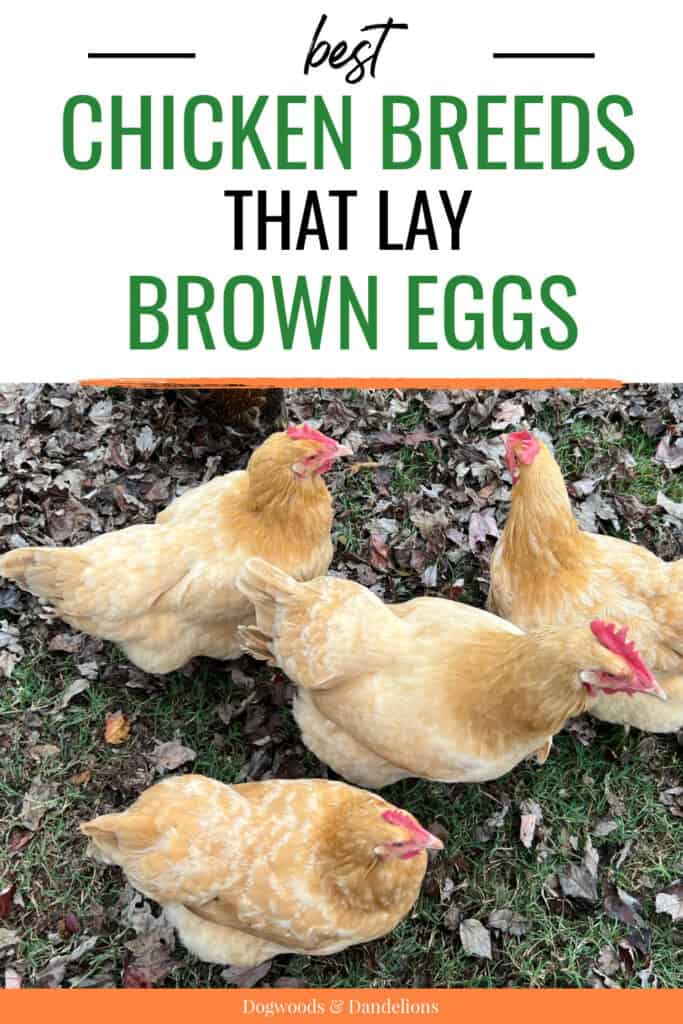Best Chicken Breeds That Lay Brown Eggs
Inside: Learn the best chicken breeds that lay brown eggs so you can choose the right chickens for your flock.
If you are wanting to get chickens for the first time or add to your existing flock, you may want to add some brown egg laying breeds. These are some of the best chicken breeds that lay brown eggs.
If you want to have a mixed color egg basket:
- The best chicken breeds that lay blue eggs.
- The best breeds that lay white eggs.
- The friendliest chicken breeds.
And while egg color has no bearing on the egg’s nutrition, it can be fun to have a variety of colors in your egg cartons. And depending on your needs, different types of chickens work better for neighborhoods, homesteads, or farms.
These are some of the best egg-laying chicken breeds that lay brown eggs.
Australorps
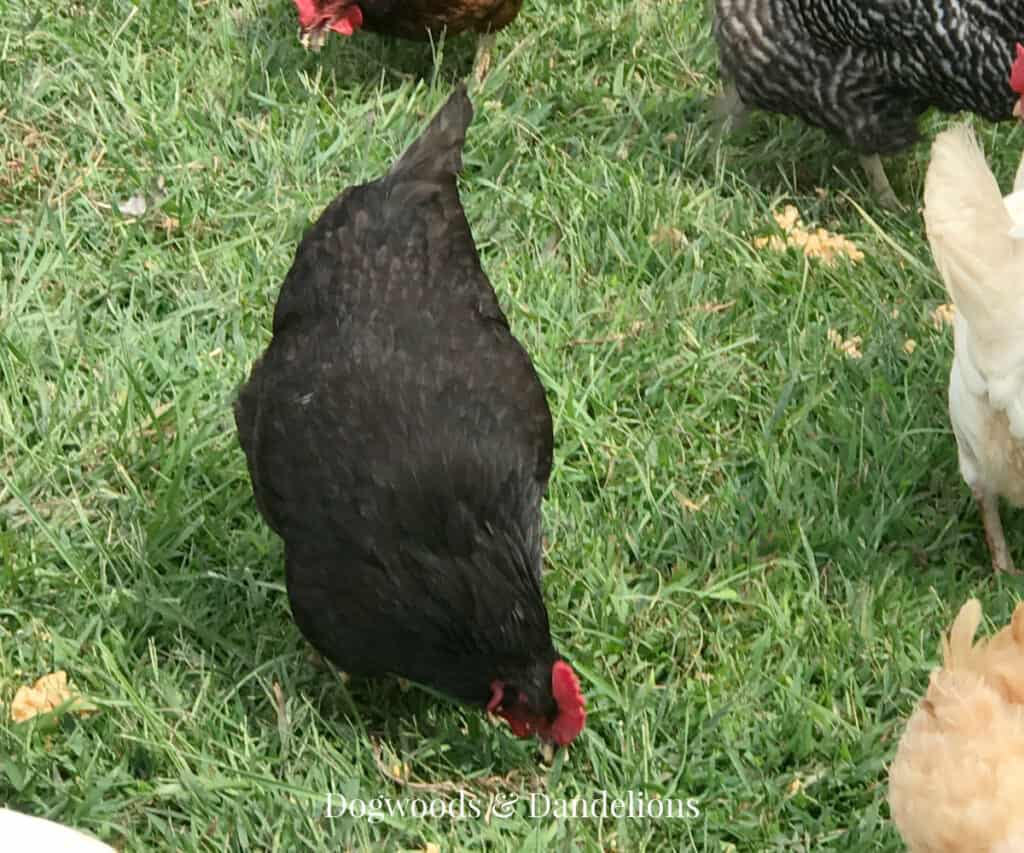
The Australorp breed was developed using Black Orpington stock (hence the ‘lorp’ in the name.). Australorp hens are generally friendly and make great pets for children.
Black Australorps have gorgeous black feathers that take on a shiny green sheen in the sunlight.
They are a large, quiet breed perfect for a small coop in a neighborhood. They have a meaty frame so they are a good dual purpose breed for the homestead as well.
Australorps are quite hardy and can handle cold temperatures and confinement well. However, they can be susceptible to heat stroke due to the dark feathers. They are great foragers if allowed space to free-range.
Australorps will provide you with a steady supply of brown eggs all year long. Supposedly an Austalorp hen holds the record for laying the most eggs (364) in a single year!
The hens can be broody so this can be a positive or negative trait, depending on whether or not you want to hatch chicks. But Australorp hens tend to be good mothers so if you do want chicks, you can leave the job of raising them to the hen.
Australorps are a heritage breed that is making a comeback in the United States. They also make an excellent chicken to show since they have a docile demeanor and are easy to handle.
Brahmas
Brahmas are large birds that can grow close to 10 pounds at maturity. They have lots of downy feathers on their body and feathers on their feet and legs. This is a quiet breed suitable for a neighborhood.
Brahmas are an excellent chicken for colder climates due to all their feathers, but they aren’t a good choice for warm climates. They have very docile personalities and don’t tend to stray far from their home.
Due to their size, they aren’t likely to fly over all but the lowest of fences. However, their large size also means they will eat more feed than smaller breeds.
Since Brahmas don’t fly well, they need a low roost to sleep on so keep this in mind when designing your coop if you are interested in raising this breed.
Brahmas were originally considered a meat breed but they lay well, about 200 eggs a year. They also tend to lay during the winter, so this breed can be a good choice to keep providing eggs for your family when other breeds stop.
Barnevelder
Barnevelder chickens can lay 3-4 dark brown eggs each week (150-200 per year). Like Brahmas, they often lay throughout the winter months and are a good choice for a family with small children since even the roosters are usually docile.
They love to free-range but can handle confinement. They are hardy birds and their friendly personalities make them an excellent choice for backyard chicken keepers.
Barnvelders tend to be “chatty” but their noise isn’t as loud as other breeds. But this is something to consider if you have close neighbors. They also make an excellent show bird for poultry and 4-H exhibitions.
Barred Rock
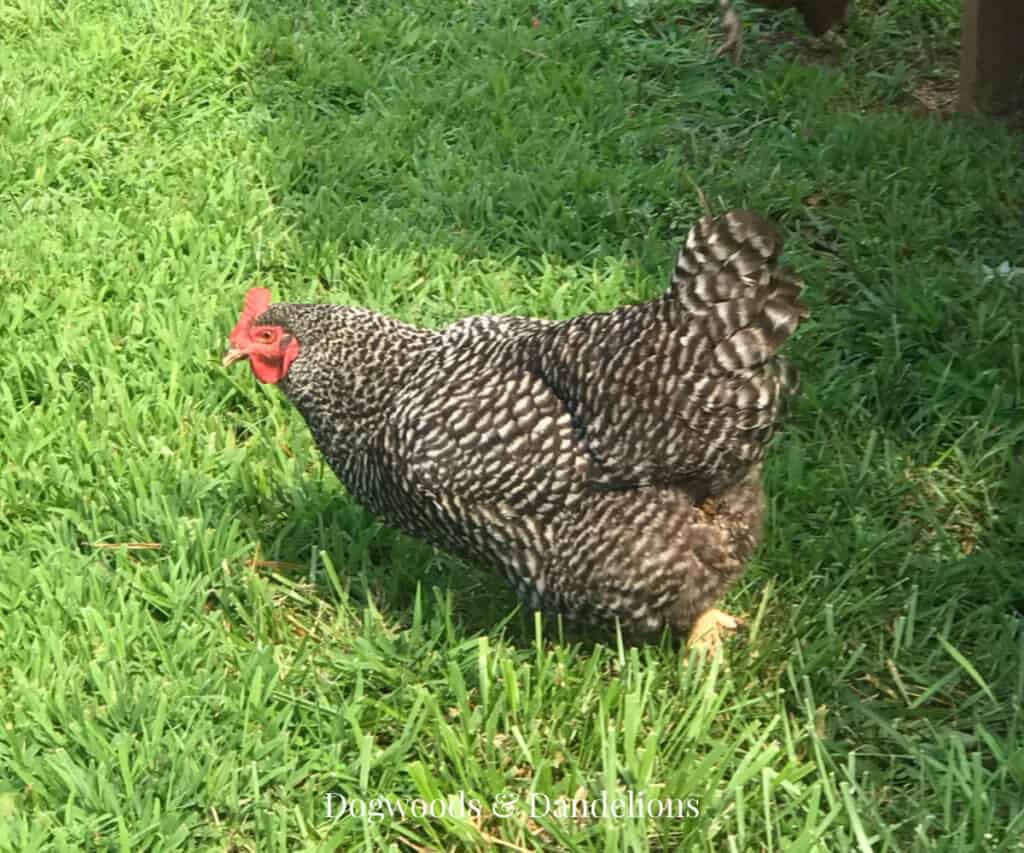
Barred Rock chickens (also called Barred Plymouth Rocks) are black chickens with white “bars” on their feathers, hence the name. They lay light brown eggs and are generally fairly quiet birds so they are a good choice for a backyard flock.
While most people claim Barred Rocks are a friendly, docile breed, the 2 we raised were the meanest chickens we’ve ever had. I’m guessing we just got 2 with bad genetics, which is always possible no matter which breed you choose.
Each Barred Rock hen will lay about 200 eggs per year.
Barred Rocks are also a great dual purpose bird if you are interested in chickens for both eggs and meat.
Buff Orpington
Buff Orpingtons are a light brown “buff-colored” chicken that makes a great addition to your flock. They are mid to large-sized chickens that lay well (200-280 eggs per year), even through the winter.
Orpingtons are considered a dual-purpose breed meaning they lay eggs well, but they are also meaty enough to butcher if you so choose.
Buffs are generally one of the quietest breeds of chickens so they work well in a neighborhood. They lay light brown eggs and some have said they are the “golden retriever” of the chicken world because they are so friendly.
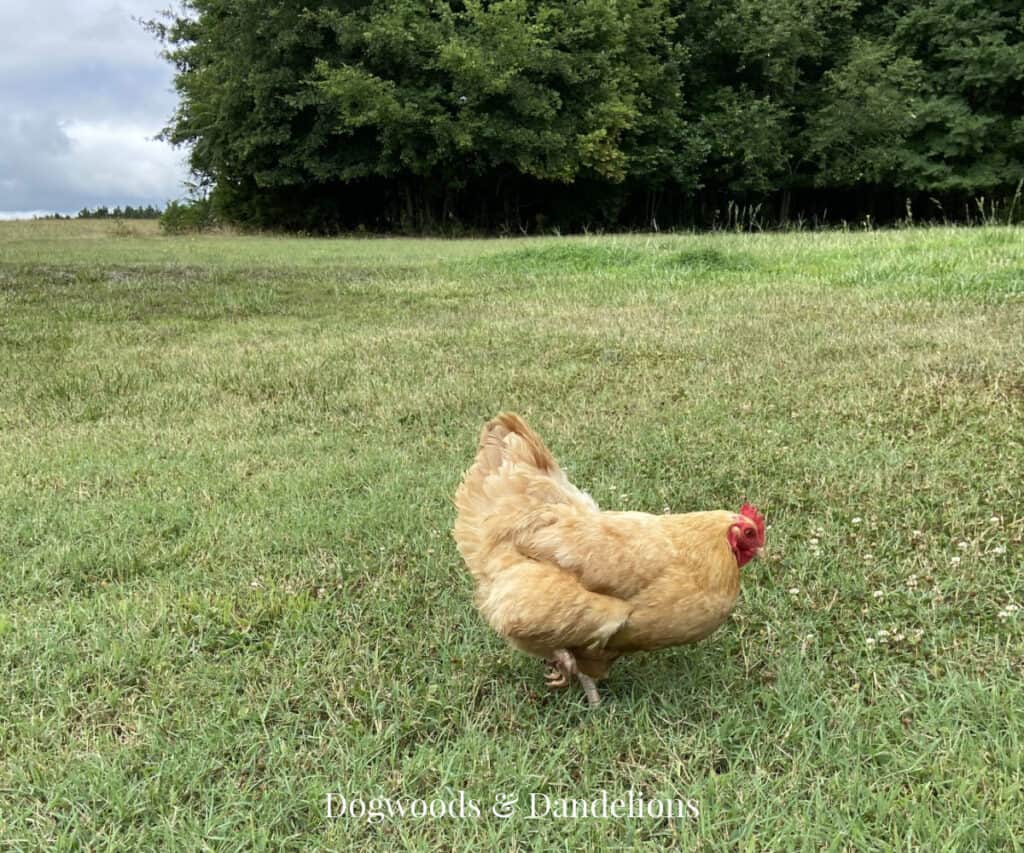
We have had quite a few Buffs and they have been a great chicken for our flock. We have one, Thelma Lou, shown in the picture above, that will actually come to you if you say her name.
They are a wonderful breed for families with small children since the birds tend to be so calm. Our Buffs tend to follow us all over the yard hoping for a few treats.
They tend to have lots of fluffy feathers and lay eggs well into their later years. (We have a 6-and-a-half-year-old Buff that is still laying several eggs a week.)
Buff Orpington hens will occasionally go broody but they make excellent mothers. While some experts say they aren’t good foragers, if you have some other breeds in your flock that do forage, they will usually “teach” Buffs how to find bugs and treats.
But because Buffs tend to prefer feed over foraging, they are a good choice if you have to keep your flock contained to a coop and run. Because of all their wonderful qualities, Buff Orpingtons are my first choice for chicken breeds that lay brown eggs.
Golden Comet
Golden Comets are a cross between White Leghorn or White Rock hens and Rhode Island Red or New Hampshire roosters. They are an excellent choice for the chicken coop because they start laying early and they lay a lot of eggs – up to 330 a year.
This is a popular breed for small farms that want to sell eggs since they lay so well but they are great chickens for the backyard flock too.
However, the trade-off for their high egg production is that they often don’t live as long as other breeds. They also are a small breed which means they are a good breed for small spaces but not a good choice for meat production.
Golden Comets are extremely friendly and some say they would rather hang out with people than their own flockmates. They are likely to try to avoid fights with others so they do best with other friendly breeds.
Golden Comets also handle confinement well but do enjoy some free range time. They are also both heat and cold tolerant.
Isa Brown
Isa Browns are good layers of large brown eggs. This is another cross between a White Leghorn and a Rhode Island Red chicken.
They are a friendly breed so they make a great choice for first-time chicken keepers and they handle confinement well. They aren’t a good chicken though if you plan to breed them as the offspring can be prone to kidney ailments and won’t necessarily be like their parents.
Isa Browns were bred to lay lots of eggs (300+ a year) but this also comes with pitfalls. Many Isa Browns develop illnesses after 2-3 years. So if you want chickens that live a long time, this is probably not the breed for you.

Marans
The Marans breed actually has several varieties but the most popular is the Black Copper Marans. They are prized for their dark chocolate-colored eggs.
They aren’t necessarily the friendliest dark brown egg layers, but they will do fine in a backyard if you aren’t looking for pets. Most Maran hens will lay about 200 eggs per year.
And while they are decent egg layers, they do have a few downsides. For some reason, the Marans breed is difficult to sex at hatch. Most hatcheries are usually correct about 90% of the time. However, with Maran chicks, that often falls to about 75%
What this means for the beginning chicken keeper is that you are likely to not get all hens. If you are just keeping a few hens for eggs in your backyard, this can be a real problem as you may get a rooster (or several) and have to figure out what to do with him (or them.)
New Hampshire Red
New Hampshire Red chickens are great dual-purpose birds for a backyard flock. They are similar to Rhode Island Reds with their brownish-red feathers and single combs, however, the New Hampshires tend to have lighter color feathers.
The temperament of New Hampshires can vary greatly. Some are very docile while others can be quite aggressive, especially with other flock mates. This is something to keep in mind as they may bully some calmer breeds.
New Hampshires take well to confinement but they are also great foragers if given space to free-range. This is another good dual-purpose breed if you want both eggs and meat from your flock.
New Hampshire hens tend to go broody but they make excellent mothers. The hens lay approximately 200 light brown eggs per year.
Rhode Island Red
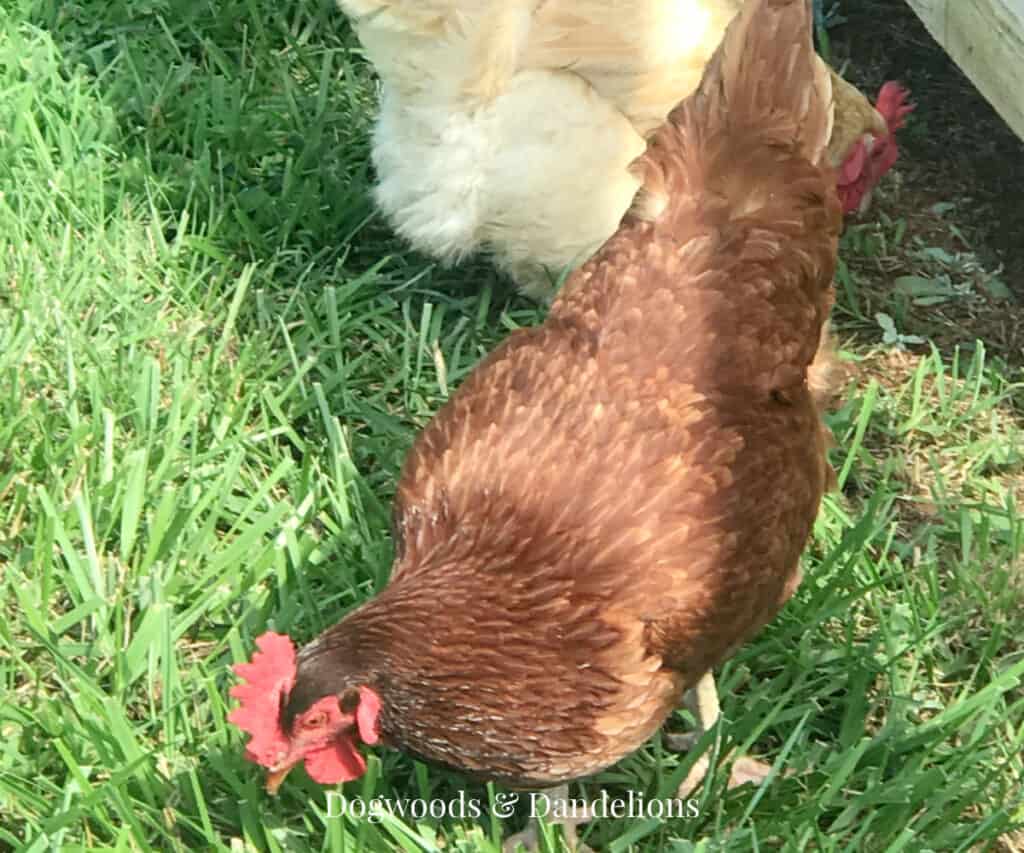
Rhode Island Reds are an outstanding breed for the backyard chicken keeper. They are a dual purpose breed that is hardy in cold climates but they are actually a good choice for warm climates too.
Rhode Island Reds have beautiful dark, rusty brown feathers and they lay lots of brown eggs, 200-300 per year. Though many people say this is a docile breed, we’ve found that the roosters tend to be quite aggressive so they may not be the best choice if you have small children.
Rhode Island Reds also tend to have a lot of personality but can be a bit noisy so keep this in mind if you live in a quiet neighborhood.
Sex-Linked Chickens
Most sex-linked chickens lay brown eggs. Red Sex-Linked, Black Sex-Linked, and Amberlinks are all sex-linked chicken breeds. (A sex-linked chicken means that you can tell when the chick is born whether it is a rooster or a hen by the color of its feathers or some other identifying trait.)
Red and black sex-linked chickens lay large brown eggs. Amberlinks are a small to medium breed with medium brown-colored feathers that lay medium-sized brown eggs.
They are all good layers and lay quite a few brown eggs each week, between 250-300 eggs a year.

One of the main reasons many people choose sex-link breeds is that when you purchase your chicks, you can be reasonably sure you are getting all hens.
This is an added bonus if you keep chickens in a neighborhood that doesn’t allow roosters. Then you don’t have to worry about what to do with a rooster should you accidentally get one.
Speckled Sussex
Speckled Sussex chickens are good egg layers of large brown eggs. They tolerate cold weather well so they are an excellent choice for cold climates.
The Speckled Sussex hens tend to go broody but they make great mothers and are good foragers so given room to free-range, they can keep food costs down. Most hens will lay about 200-240 eggs per year but Sussex is a good meat breed as well.
They tend to be friendly and curious so they may follow you around the yard hoping for treats.
Many times the Sussex chickens will lay right on through the winter when other breeds have stopped. Sussex chickens make a great farm or homestead chicken as they are adaptable to a variety of conditions.
Welsummer
Welsummer chickens produce eggs that are a dark brown color, sometimes with brown speckles. They are great foragers with a calm, docile temperament. Even most roosters are friendly.
Welsummers do tend to be a noisy breed but the hens aren’t likely to go broody and they don’t usually make good mothers. The birds aren’t good fliers so they are easy to keep contained.
A Welsummer hen will lay approximately 150-250 eggs a year.
Wyandotte
The Wyandotte chicken is a beautiful chicken with several different varieties. I personally think the Golden-Laced Wyandotte is one of the prettiest chickens around.
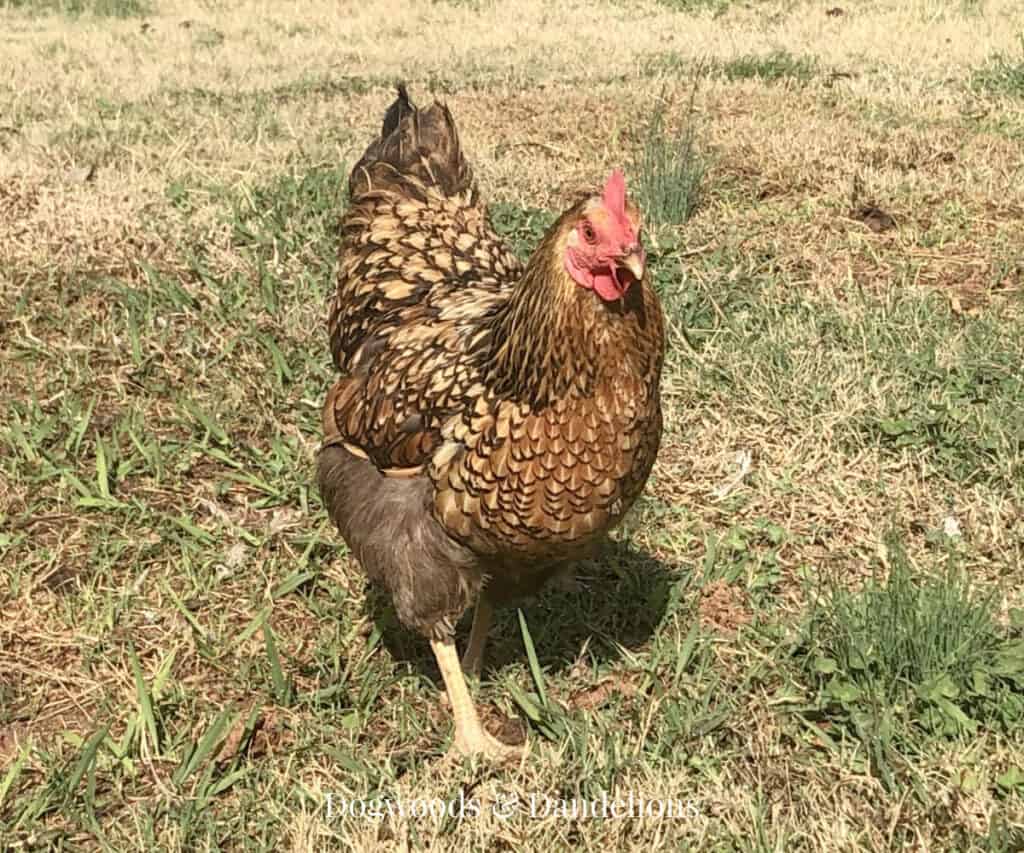
The Silver Laced Wyandotte was the original color pattern but now there are many other colors including white, buff, silver penciled, and golden-laced.
Wyandottes lay about 4 eggs per week (200 per year) according to most sources. However, the Wyandottes in our flock have laid 6-7 eggs per week. The only breed that we’ve kept that has laid more eggs is the White Leghorn!
I can’t say enough good things about this breed. They tend to be friendly birds, are beautiful to look at, and are definitely a good choice for your backyard flock whether you live in a neighborhood or on a farm. They are active foragers but handle confinement well too.
Wyandottes would definitely be my first choice for the best chicken breeds that lay brown eggs.
Choosing the Best Brown Egg Layers for Your Flock
There are many heritage breeds as well as hybrid breeds to add diversity and colorful eggs to your flock of backyard chickens. Hopefully, this information has helped you choose the right breed (or breeds) for your backyard flock.
Related Posts
- The Best Blue Egg Laying Breeds
- The Best Chicken Breeds That Lay White Eggs
- Chicken Breeds by Egg Color

Meet Julie
I’m a farm girl born and bred in North Carolina. I’ve been growing a vegetable garden for over 20 years (and helping my Mom grow hers even longer). I’ve been raising chickens in my bathtub and backyard for 12+ years. I believe that homegrown food can be made simple. Let’s get started.
